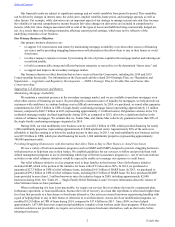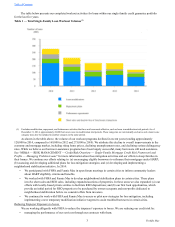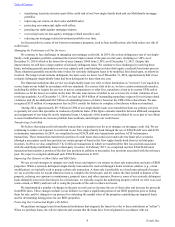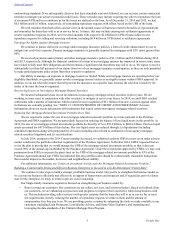Freddie Mac 2014 Annual Report Download - page 17
Download and view the complete annual report
Please find page 17 of the 2014 Freddie Mac annual report below. You can navigate through the pages in the report by either clicking on the pages listed below, or by using the keyword search tool below to find specific information within the annual report.
12 Freddie Mac
during 2014. Wells Fargo Bank, N.A. accounted for 13% of our single-family mortgage purchase volume and was the only
single-family seller that comprised 10% or more of our purchase volume during 2014.
A significant portion of our single-family mortgage loans is serviced by several large servicers. Our top two single-family
loan servicers, Wells Fargo Bank, N.A. and JPMorgan Chase Bank, N.A., serviced approximately 22% and 12%, respectively,
of our single-family mortgage loans as of December 31, 2014 and were the only servicers that serviced more than 10% of our
loans at that date. For additional information about servicer concentration risk and our relationships with our seller/servicer
customers, see “MD&A — RISK MANAGEMENT — Credit Risk Overview — Institutional Credit Risk Profile — Single-
Family Mortgage Seller/Servicers.”
Our Competition
The principal competitors of our Single-family Guarantee segment are Fannie Mae, Ginnie Mae (with FHA/VA), and
other financial institutions that retain or securitize mortgages, such as commercial and investment banks, dealers, and thrift
institutions. We compete on the basis of price, products, the structure of our securities, and service. Competition to acquire
single-family mortgages can also be significantly affected by changes in our credit standards. The conservatorship, including
direction provided to us by our Conservator, may affect our ability to compete. For more information, see “RISK FACTORS —
Conservatorship and Related Matters — Competition from banking and non-banking companies may harm our business."
Guarantee Fees and Contractual Arrangements
We enter into mortgage loan purchase volume agreements with many of our single-family customers that outline the
terms under which we agree to purchase loans from them. For the majority of the mortgages we purchase, the management and
guarantee fees are not specified contractually. Instead, we bid for some or all of the lender's mortgage loan volume on a
monthly basis at a management and guarantee fee rate that we specify. Our mortgage loan purchase volumes from individual
customers can fluctuate significantly.
We seek to issue guarantees with fee terms that we believe are commensurate with the risks assumed and that will, over
the long-term: (a) provide management and guarantee fee income that exceeds our anticipated credit-related and administrative
expenses on the underlying loans; and (b) provide a return on the capital that would be needed to support the related credit risk.
However, we must obtain FHFA’s approval to implement across-the-board increases in our guarantee fees. We do not have the
ability to fully price for our credit risk at the loan level as our base fee does not differentiate by LTV ratio and credit score. To
compensate us for higher levels of risk in some mortgage products, we charge upfront delivery fees above our base fees, which
are calculated based on credit risk factors such as the mortgage product type, loan purpose, LTV ratio and credit score. While
we vary our guarantee and delivery fee pricing for different customers, mortgage products, and mortgage or borrower
underwriting characteristics based on our assessment of credit risk, the seller may elect to buy, or originate, and then retain
loans with better credit characteristics. The sellers' decisions for loan retention, or sale to us, could result in our portfolio
purchases having a more adverse credit profile.
We implemented two across-the-board increases in guarantee fees in 2012. Effective April 1, 2012, at the direction of
FHFA, we and Fannie Mae increased the guarantee fee on single-family residential mortgages sold to us by 10 basis points.
Under the Temporary Payroll Tax Cut Continuation Act of 2011, the proceeds from this increase are being remitted to Treasury
on a quarterly basis to fund the payroll tax cut. We refer to this fee increase as the legislated 10 basis point increase in guarantee
fees. In the fourth quarter of 2012, at the direction of FHFA, we and Fannie Mae implemented a further increase in guarantee
fees on single-family mortgages of an average of 10 basis points.
Securitization Activities
Our securitization activities primarily involve PCs, and REMICs and Other Structured Securities. We have not completed
an Other Guarantee Transaction in our Single-family Guarantee segment in several years. In order to expand our alternatives
for the transfer of mortgage credit risk to third party investors, we may resume issuing Other Guarantee Transactions in our
Single-family Guarantee segment in 2015. See "Our Business — Overview of the Mortgage Securitization and Guarantee
Process” for additional information about our securitization activities.
Single-Family PC Trust Documents
We establish trusts for all of our issued PCs pursuant to our PC master trust agreement. We use PC trusts to hold the
underlying mortgage loans separate and apart from our corporate assets. In accordance with the terms of our PC trust
documents, we have the option, and in some instances the requirement, to remove specified mortgage loans from the applicable
trust. To remove these loans, we pay the trust an amount equal to the current UPB of the mortgage loan, less any outstanding
advances of principal that have been distributed to PC holders. Our payments to the trust are distributed to the PC holders at the
next scheduled payment date.
We have the option to remove a mortgage loan from a PC trust under certain circumstances to resolve an existing or
impending delinquency or default. Our practice generally has been to remove substantially all single-family mortgage loans
that are 120 days or more delinquent from our issued PCs. From time to time, we reevaluate our practice of removing
delinquent loans from PCs and alter it if circumstances warrant.
Table of Contents
























